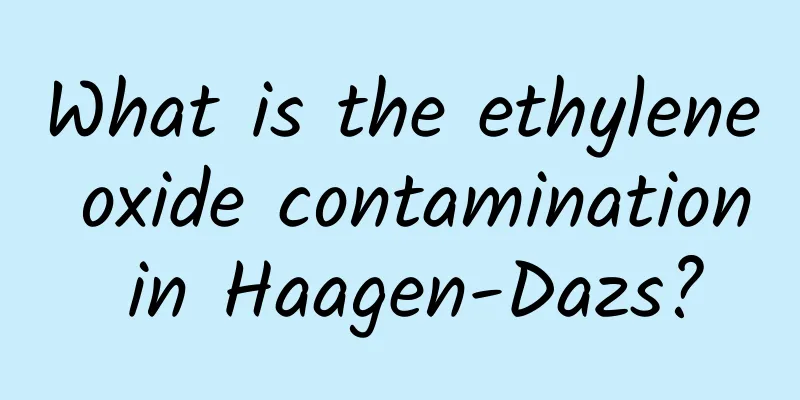What is the ethylene oxide contamination in Haagen-Dazs?

|
Ice cream has been a hot topic recently. The Taiwan Food and Drug Administration released a list of unqualified foods for border inspection, and two batches of Haagen-Dazs vanilla ice cream exported from France were found to contain the toxic ingredient "ethylene oxide". Haagen-Dazs importer General Mills China responded in a letter stating that the two batches of products imported from Taiwan were not sold in mainland China. Regardless of whether it is sold in mainland China, the frequent problems with this high-priced ice cream make people have to question: What is wrong with ice cream nowadays? Can we still eat it with confidence? Today, let’s talk about what is the ethylene oxide pollution in Haagen-Dazs? 01. What is ethylene oxide? Ethylene oxide, commonly known as EO, has a chemical formula of C₂H₄O. This thing has an important use: sterilization. Because ethylene oxide is a broad-spectrum sterilant, at room temperature, all kinds of microorganisms are no problem. For example, common tuberculosis bacteria, bacteria, viruses, fungi, etc. in medicine can all be killed. Moreover, this thing has many advantages: 1. Sterilization at room temperature In the sterilization measures we are familiar with, high temperature sterilization is often required. For example, biological laboratories prefer 121℃ sterilization. Although it is good quality and cheap, some things are not resistant to high temperature, such as this compression cuff. There are also various silicones and catheters, which cannot be exposed to high temperatures, otherwise they will denature. So this is the first advantage of ethylene oxide. However, many people probably think of another thing: alcohol. Can't this thing also be sterilized at room temperature? This raises another question: water. 2. No water Ethylene oxide does not contain water, so it can be used directly. However, ethanol is different. The ethanol that can be used for disinfection is 75% concentration, which means it contains 25% water. In actual disinfection, after the ethanol evaporates, what is left is water. In medicine, some equipment cannot be exposed to water, such as various electronic instruments. However, medical sites are often faced with various microbial problems, so disinfection is necessary, so ethanol is not recommended. Because of this, ethylene oxide can be used for medical disinfection and is widely used. 02. What are the hazards of ethylene oxide? In fact, it is a simple truth that anything that can be disinfected must be harmful. Disinfection kills bacteria and other microorganisms, so how can human cells withstand such lethality? Ethylene oxide, as a common low-temperature disinfectant, is no exception. Ethylene oxide is a type of carcinogen on the list of carcinogens published by the World Health Organization's International Agency for Research on Cancer, which means it is clearly carcinogenic to humans. Of course, inhaling this stuff can pose a threat to human health, such as irritation and damage, especially to the skin. So this thing is quite troublesome. 03. Why is ethylene oxide mixed in? 1. Disinfection? Not likely, it is illegal The first thing that comes to mind is disinfection. After all, ethylene oxide is a common low-temperature disinfectant and is widely used. However, ethylene oxide is explicitly prohibited from being used for food disinfection. Ethylene oxide fumigation was once widely used in food, but it left residues, so people were poisoned without knowing it. Later, it was phased out in the food industry. For example, Germany banned the use of ethylene oxide to fumigate food in 1981, as did many other countries. my country is also the same. In my country's "Technical Specifications for Disinfection", it is clearly stated that ethylene oxide is not suitable for food sterilization. 2. Food packaging This possibility is not small, that is, ethylene oxide may appear in many food packaging. There are two main ways. One is that when the food packaging is printed, the ink will be mixed with ethylene oxide; the other is that when the finished package is disinfected, such as when passing through customs, it may be contaminated there and cause residues. After all, customs disinfection is common nowadays. However, if other foods do not appear, but only Haagen-Dazs has it, it is hard to say whether this possibility exists. 3. Raw materials mixed This possibility is quite high, because this happened in 2021, when ethylene oxide was detected in ice creams of brands such as Nestlé and Milka produced by Froneri, and they were eventually recalled. The reason was accidental contamination by a raw material supplier. In addition, last year, ethylene oxide was also detected in Godiva ice cream imported from France. On December 9, 2021, the Food Safety Centre of the Food and Environmental Hygiene Department of Hong Kong, China issued a press release advising the public not to consume six types of "GODIVIA" French imported ice creams because the stabilizers used in the relevant products were found to contain ethylene oxide, a pesticide banned by the European Union. One possibility for the raw materials is the use of pesticides. For example, in 2020, an ethylene oxide contamination outbreak occurred in India due to the use of ethylene oxide as pesticide. Therefore, the final judgment still depends on the results of Haagen-Dazs's traceability investigation. |
>>: Deep Sea Cemetery: The Death of a Whale
Recommend
How to use Apple mobile phone and watch together to open touch experience?
A few days ago, a plastic back cover model of wha...
The rainstorm came, the crocodiles ran away, and the local response: Try not to go out...
On September 11, a video circulated online said t...
MIUI will "go out" on two legs
On July 5, Xiaomi MIUI director Hong Feng reveale...
To prevent the power strip from "getting angry", you should do this...
recently A fire broke out in a resident's hom...
What is the best way to attract traffic to mini programs? How to promote and attract traffic to WeChat mini programs?
Q: What is the best way to attract traffic to min...
TSMC: 4Q20 revenue reached US$12.68 billion, up 22% year-on-year
On January 14, 2020, TSMC, the leading wafer foun...
Double "new evidence" support! Good news for melanoma patients!
At the just-concluded 2024 European Society for M...
This article is enough for tips on how to maintain a Douyin account!
There are many debates online about "raising...
Why can’t you find coconut water and coconut flesh in the coconuts you eat?
I still remember the first time I ate coconut, I ...
Which industries generally use 10G bandwidth for server rental?
Which industries generally use 10G bandwidth for ...
Product Analysis Report丨How does WeChat Reading retain users?
I have always believed that reading is a solitary...
Dismantling Spark Education’s K12 Education Operation Growth Strategy
Today's case comes from Chen Xi, an outstandi...
Can the sun generate electricity? The sun can generate electricity!
The progress and development of society cannot be...
How to obtain seed users?
Many Internet products encounter two problems dur...
Why do humans have hair?
I believe you have already discovered that humans...









